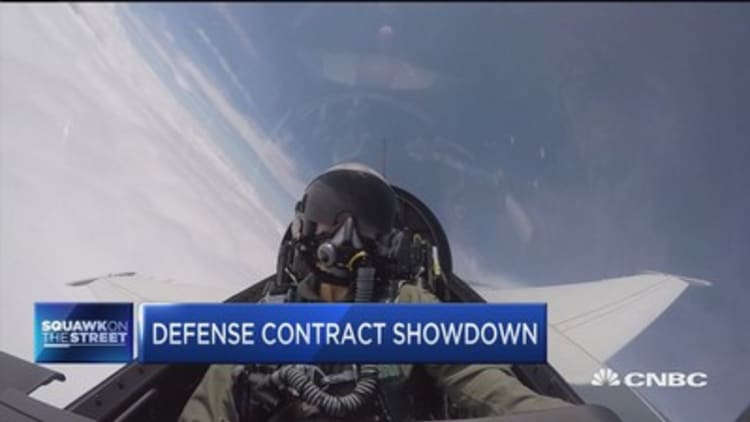
President Donald Trump has repeatedly pledged to rebuild the military, while simultaneously lamenting weapons' costs.
Given budget impasses on Capitol Hill, his big spending plans have been met with a healthy dose of skepticism. But to better understand how America's armed forces could truly undergo a "great rebuilding" as costs come down, look no further than the U.S. Air Force's Advanced Pilot Training competition, known as the T-X Trainer.
The T-X Trainer is one of the biggest defense contracts currently up for grabs. With a $16.3 billion stated program of record, the Air Force plans to purchase 350 next-generation jet trainers that would be used to teach new pilots to fly fighters including the F-16 Fighting Falcon, the F-22 Raptor, and of course, the F-35 Joint Strike Fighter.
The Air Force wants those future planes operational by 2024. The contract is, for now, expected to be awarded at the end of this year.
The plan to replace the rapidly aging fleet of existing trainers has been a long time coming: the currently used T-38 Talons, made by Northrop Grumman, have been in service since the early 1960s, and experts say they won't last past 2030.
"I think the public would be surprised to find out that the average age for a trainer today, the T-38, is nearly 50 years old, and that the mission-capable rate is around 62 percent," says Howard Rubel, a managing director at Jefferies, covering defense stocks.
For most high-performance aircraft, the goal is a mission-capable rate
After a dramatic shift in offerings that involved both Raytheon and Northrop Grumman recently dropping out, the T-X Trainer competition comes down to three main teams: Lockheed Martin, partnered with Korea Aerospace Industries; Boeing, partnered with Saab; and Italian contractor Leonardo, partnered with its own U.S. subsidiary DRS Technologies.
Lockheed's offering is the T-50A, an upgraded version of the T-50 Golden Eagle that South Korean pilots currently train in. Boeing has built a "clean sheet" trainer from the ground up directly to the Air Force's contract specifications, spending what analysts estimate is $1 billion to $3 billion of its own money on development.
Leonardo is proposing its T-100, a trainer already teaching F-35 pilots how to fly in Israel and Italy.
Amid budget constraints and a big focus on the financials within the Pentagon, industry insiders say the close competition is quickly devolving into a bidding dogfight — a price shootout to the, in military jargon, "lowest price technically acceptable."
Leonardo, which parted ways with Raytheon earlier this year, believes it has the lowest cost bid for the program. It promises to build a new factory that will create new jobs. Boeing says its trainer went from concept to flight in 36 months, with a supply chain ready to go and that new design enabling it to employ more cutting-edge manufacturing techniques than its competitors.
As for Lockheed, CNBC got a
"We can deliver new trainer aircraft at least two years ahead of the Air Force's schedule. And the reason we can do that on a very predictable, low-risk, on-schedule, on-time,
"Lockheed has an edge because it doesn't have development costs, but Boeing has a nice design, and if they aggressively bid they could take this," explains Richard Aboulafia, vice president of analysis at Virginia-based industry consultancy Teal Group.
But it
"With that training solution, we change the entire method of training students," says Lockheed chief test pilot, Mark "Red" Ward. Most recently, Ward test-flew F-35s for the company, which makes that fighter jet. A former Air Force pilot, Ward first learned to fly on the same T-38s used today.
"Right now, all of that is done in the fourth- and fifth-generation planes, but now we can do it in this training system so that when they transition, we have a student that already knows … the tasks required so we can shorten the end-product training," explains Ward. "If he's going to an F-16, F-35, F-22, we can shorten that from maybe 6 to 8 months all the way to 4 to 6 weeks."

In other words, a new software-enabled system will shift the training risk away from expensive fighter jets to simulators, and since pilots wouldn't have to do so much training
But there are unknowns — not the least of which is the budget. The federal government continues to operate under a Continuing Resolution, for now; most experts expect gridlock to plague the defense budget in
Meantime, competitors are proceeding as if those challenges won't emerge, focusing on taking planes up to rack up the required flight hours and collect the required data. And of course, they are also pushing out big marketing pitches — pitches heavy on cost-cutting verbiage and job creation.
"This is gonna be a hard-fought competition," says Griswold.


